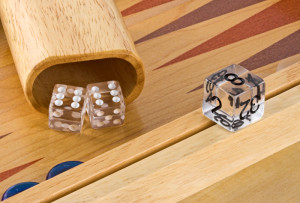Contents - Quicklinks
Backgammon is the most seasoned recorded game played by man. But the doubling cube only entered into backgammon play in the 1920s. The introduction of the doubling cube into the game is largely responsible for the leap in popularity of modern backgammon. Numerous backgammon players have never utilized a doubling cube, yet it brings a lot of new system into the game. Read on to see how you can utilize it as well.
History of the Cube
The backgammon doubling cube was first used at the Knickerbocker Club in New York. Around mid to late 1920s, a backgammon player in New York City introduced doubling in backgammon, adding a radical new viewpoint to the game while igniting new life to it in an era when it had turned out to be exceptionally trendy. And in 1926 the first use of doubling in Europe was held in a game played in Paris between The Grand Duke Dmitri of Russia and Aksel de Wichfeld of Denmark. Grand Duke Dmitri is one of the only members of the family to escape the Bolsheviks and survive the murders of the royal family.
A doubling cube is a die (little larger than a regular die) marked with the numbers 2, 4, 8, 16, 32, and 64. It is utilized to allow players to bet on the game as they are playing, with the face-up value signifying the multiple of the original stake set at the start of a game that the winning player, wins toward the end.
What is the doubling cube in backgammon
At the beginning of play, the doubling cube lays on the bar, between the two players, or along the edge of the board. This position indicates that both players have access to it. That is, either player can make the first double. As the game progresses, if a player feels they have an advantage, before they roll, they may choose to offer a double (which means that the total stake will be doubled). The opponent may decline or accept the double. On the off chance that opponent denies the double, the opponent immediately loses his (undoubled) stake and the game is over.
If the opponent accepts the double, the stakes are doubled and, as a compensation, the doubling cube is handed over to him and he gets the selective right to declare the next double. A player who accepts a double becomes owner of the cube and only he may make the next double in the same game.
If the game later turns around and the player who owns the cube feels he now has an advantage, he may announce a so-called redouble, which means that the stake is doubled again. If the first player refuses the double, they now lose the doubled stake; if they accept, the game goes ahead with an increased stake, four times the original value.
Pro tip: You cannot double again if the doubling cube is in the possession of your opponent. Keep this in mind, as an ill-placed double can give your opponent even more leverage down the line.
Cube Strategies
The doubling cube can be a fierce weapon in any backgammon game, so it’s always a good idea to practice with and get better with and learn how to use the doubling cube in backgammon. You can avoid a bad beat with a well placed double (which forces your opponent to fold vs chase his luck), or gain some extra points because your opponent accepted your double hoping to win by pure luck.
You may like: Backgammon Strategy Guide – Get Better at Backgammon
Modern Backgammon Doubling Cube
Often referred to as the gambling dice, backgammon doubling cube is an awesome invention, and it is a famous innovation, and it is a mainstream gambling device. But surely gambling on backgammon hardly began with the addition of the doubling cube. If you are familiar with any of the many tournaments all over the world, you would find players including France, US, Greece, and Egypt enjoying backgammon with the doubling cube. You would also find that the vast majority of players playing with the doubling cube do not gamble. And yet they enjoy the game. Most players use backgammon for precisely the same reason that you find so admirable among players: it’s a way of socializing.


